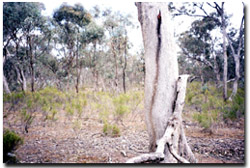Site 21 Runnymede Flora and Fauna Reserve
This site is of uncertain environmental stability
Description
This site is now a Flora and Fauna Reserve located on low sedimentary rises and is at an elevation of 205 metres. There had been some timber harvesting at the site in the past, and possibly gravel extraction. It is likely that the reserve was also previously grazed by stock. The area is reserved for conservation to protect flora and also a population of Squirrel Gliders.
| Vegetation Description and Composition The White Box vegetation community at this site represents Low Rises Grassy Woodland EVC and is listed as endangered at both the State and Federal level by the Flora & Fauna Guarantee (FFG 1988) and the Environment Protection & Biodiversity Conservation (EPBC 1999) Acts. The site is dominated by Eucalyptus albens (White Box), Eucalyptus microcarpa (Grey Box) and Cassinia arcuata (Dropping Cassinia), and contains an understorey of native species from the Asteraceae, Liliaceae (lily), and Poaceae (grass) Families. The percentage of introduced species had steadily increased until the most recent survey. Some variations are likely to be due to changes in seasonal conditions and the timing of vegetation surveys. |  Runnymede Flora & Fauna Reserve in spring 2002 |
The 2002 survey revealed a 30% decline in species numbers, mostly from introduced grasses and weeds from the Fabaceae Family.
A lower level of cover abundance was also recorded for many species and is a result of dry seasonal conditions and from grazing pressures from kangaroos, rabbits and hares.
The only salt indicator species Lolium spp. (Rye Grass) remains present. It is questionable whether the presence of this species indicates saline conditions at this site as it is a common weed and no other salt tolerant species have ever been recorded.
Tree Health
Four trees are monitored for tree canopy health using a 20-point system assessing canopy size and density, number of dead branches and extent of epicormic growth. Leaf damage by insects is also assessed. Tree health is generally quite low at the site due to trees containing reduced canopy densities and a large number of dead branches.
Groundwater and Salinity
One bore is located at the site and has recorded a large drop in the water table due to the extended dry seasonal conditions. The average groundwater depth recorded in 2002 was 13.2 m below natural surface. The salinity reading of the water was >6 000 EC (i.e. very saline water).
Birds
Bird species present at the time of the vegetation and tree health surveys were :-
Eastern Rosella, Galah, Grey Butcherbird, Kookaburra, Little Raven, Magpie, Noisy Miner, Welcome Swallow, White-plumed Honeyeater, White-winged Chough and Willie Wagtail.
Threats to the site still includes:
- gravel dumping.
- grazing by kangaroos, rabbits and hares
- continued weed invasion.


